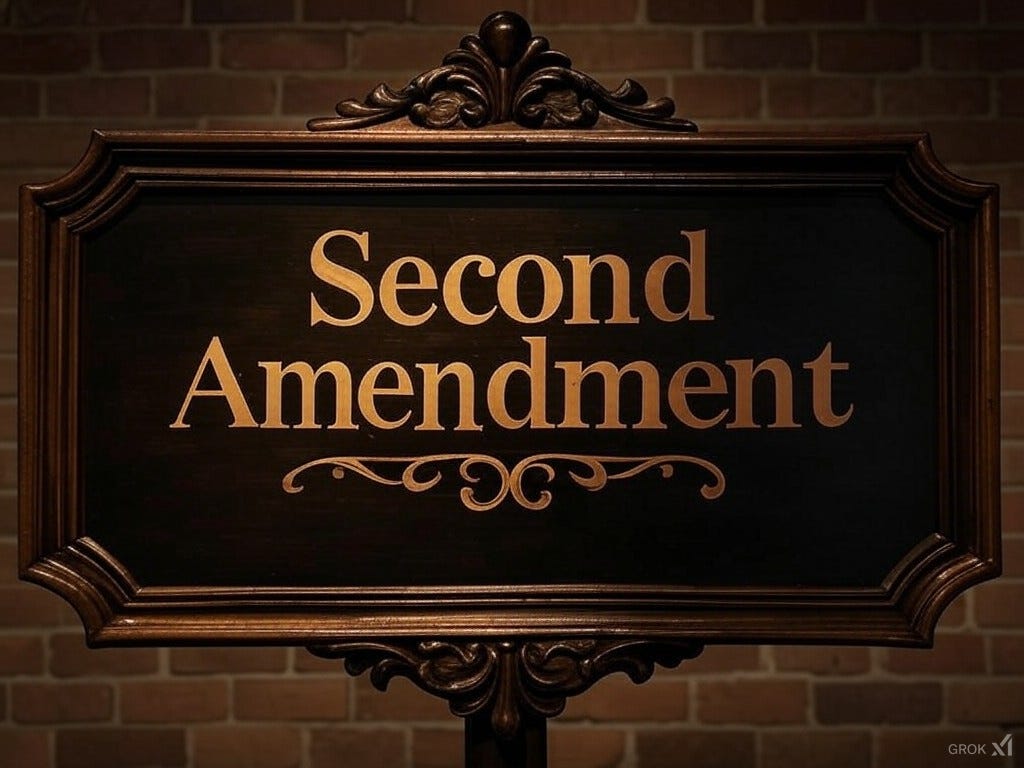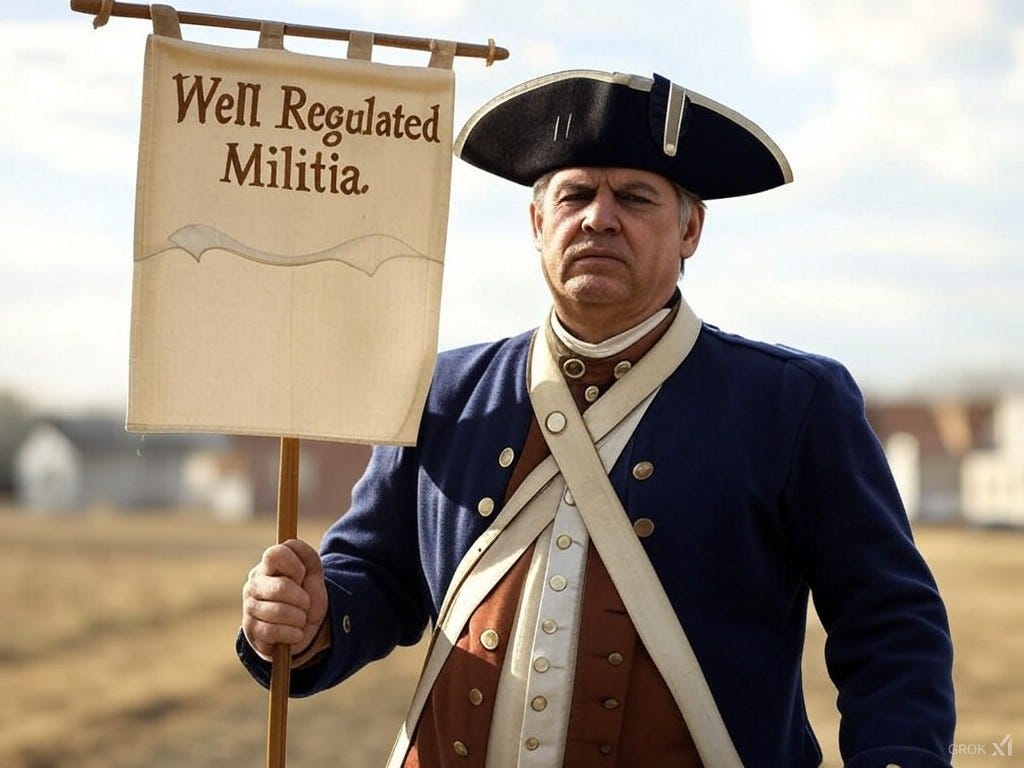The 2nd Amendment reads:
A well regulated Militia, being necessary to the security of a free State, the right of the people to keep and bear Arms, shall not be infringed.
We wrote an article on the 2nd Amendment back in October 2023. You can find it here. We recommend you read that article after reading this one.
This amendment has caused more serious conversation than any other we’re familiar with. How complex can a 28 word sentence be? Given the differing analyses of the overall meaning of the amendment, a 28 word sentence can have many meanings.
Which one is correct? Another question with many possible answers. When attempting to interpret any document, certain things must be known or assumed.
Interpreting amendments to the U.S. Constitution involves several assumptions to ensure that the interpretation remains consistent with the principles of law and the intent of the framers. Here are some key assumptions (my comments are in italics):
Historical Context: There's an assumption that understanding the historical, political, and cultural context at the time of the amendment's adoption is crucial. This includes the common language usage, political debates, and societal norms of that era.
Framers' Intent: Interpreters often assume that the framers had specific intentions which should guide interpretation. However, determining this intent can be contentious as historical records might be ambiguous or incomplete.
Plain Meaning: There's an assumption that the text of the amendment should be taken at its plain, ordinary meaning unless there's clear evidence to suggest otherwise. This aligns with the principle of textualism, where the words themselves are the primary guide.
Consistency: The assumption that amendments should be interpreted in a way that maintains consistency with other parts of the Constitution unless explicitly altered.
Adaptability: Some assume the Constitution is a "living document" that should evolve with societal changes, suggesting that interpretations should be flexible to contemporary issues.
We disagree with the idea that the Constitution is a “living document” that must be kept current with a nod to contemporary issues and norms. The Constitution was written to support and guide the United States, and as such must remain immutable in the morals, values, and enumerated powers, keeping these things consistent with the thoughts and desires of the Founders. To consider this document a “living document” is to determine that we, today, know better than those geniuses who wrote it.
Fixed Meaning: Conversely, others assume a more static interpretation where the meaning of the text should remain as understood at the time of its writing, with changes only through formal amendment.
Stare Decisis: There's an assumption that past judicial interpretations (precedents) should be respected unless there's compelling reason to overturn them. This can lead to assumptions about the stability and predictability of law.
We agree that precedent should be respected, however, in the past, decisions have been made (Roe vs Wade for example) by the Supreme Court that do not have any support in originalist analysis of the Constitution. These precedents must be reversed.
Judicial Restraint vs. Activism: There's an underlying assumption about the role of the judiciary in interpreting amendments. Some assume judges should defer to legislative intent or historical understanding (judicial restraint), while others believe judges should actively shape law to meet current societal needs (judicial activism).
Our belief is that judicial restraint or originalism should be the process used to interpret. The intent, meaning of the words at that time, and how the original amendment “fit in” with the thoughts and intent of the writers.
Common Understanding: An assumption might be made that amendments were intended to be comprehensible to the average citizen, suggesting interpretations should align with what an informed public might understand.
Amendment Process as Intent Indicator: The rigorous process of amending the Constitution is assumed to indicate significant intent behind any amendment, suggesting that changes should not be interpreted lightly or in ways that could be seen as bypassing this formal process.
Balance of Powers: There's an assumption in interpreting amendments that they should respect the balance of power between federal and state governments as originally conceived, unless the amendment explicitly shifts this balance.
These are the items that must be looked at when interpreting the meaning of an amendment. So, again, the 2nd Amendment reads:
A well regulated Militia, being necessary to the security of a free State, the right of the people to keep and bear Arms, shall not be infringed.
What does it mean? Let’s start with what is possibly the most discussed and misinterpreted portion of the amendment. A well regulated Militia, being necessary to the security of a free State, – what does that mean? Glad you asked.
Under the Militia Act of 1792, which was passed shortly after the Second Amendment, the militia was defined as all able-bodied white male citizens between the ages of 18 and 45. This act required these men to be enrolled in the militia and to provide their own arms, ammunition, and equipment (emphasis mine). This legal definition reflects how the term was intended in the Second Amendment.
So “well regulated”, in the context of the 2nd Amendment, refers to a militia being competently organized, trained, and equipped to effectively perform its military duties. The whole first clause “A well regulated Militia, being necessary to the security of a free State,” then means a fully trained and organized force of citizens who supply their own arms, ammunition, and equipment is needed to defend a free state. Each of the 13 original colonies are the free states mentioned here, so the militia (the precursor to the National Guard) was deemed necessary to defend the sovereign states under the Constitution.
The rest of this amendment falls right into place “the right of the people to keep and bear Arms, shall not be infringed.” If you codify the need of a citizen army (militia), which the amendment does, to defend the states, the militia (the people) have the right to keep (own) and bear (carry) arms.
Of course there’s more. If the militia was envisioned as the defense of the state, and the citizens were to supply their own arms, did the founders not trust, in fact require, that the people have the same level of technology that the professional armies of the day had? If you are to provide for the security of the state you have to have access to state-of-the-art weapons. So aside from protecting our rights to own and carry arms, the 2nd Amendment says the government should not limit the technologies we choose to own.
So yes, you should be able to own a cannon, or a machine gun, or a grenade launcher if you want that technology, the 2nd Amendment says you can. You can own any or as many of these devices, all the pistols and revolvers and rifles and carbines, short barreled rifles and shotguns you want. The Constitution says so.
And that’s another right given you by God that man cannot take away.
It’s about time to rectify this injustice by repealing the gun control acts and dissolving the Bureau of Alcohol, Tax, Firearms, and Explosives (BATFE) often called ATF, as regulating arms doesn’t seem to be an enumerated power.
But that’s a whole other article.
The people in Western North Carolina still need help, and it’s cold and wet in the mountains. We continue to ask that you do whatever you can to assist them.
We continue to recommend Samaritan's Purse or Mercury One as already on the ground and doing excellent work. Thank you.
If you are interested in Conservative News by Conservative Writers, take a look at Arkansas 1st News









The citizenry was to supply the people and the arms for the militia. Today, law enforcement acknowledges that they can never get there quick enough to protect you so you must make arrangements to protect yourself. And then, there is the government.
Thanks for the clarity, Jack.